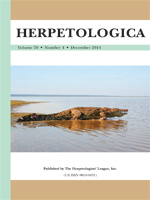Few extensive studies have addressed the ecology of South American colubrids. Spilotes pullatus is a large and conspicuous colubrid snake with a broad distribution in South America. We analyzed the morphology, habitat use, diet, feeding behavior, and reproductive biology of S. pullatus in a subtropical area of distribution, specifically in the Atlantic Forest of southeastern Brazil. We compared its ecological traits with those of other South American colubrids to identify common characteristics and differences among these snakes. Spilotes pullatus inhabits primarily lowland areas and readily occurs in altered habitats. Male and female snakes were similar in median snout–vent length, but the largest known individuals of the species are males. This snake forages actively by day, searching primarily for small mammals and nestling birds (usually 0.36–7.37% of snake mass) on the ground or in vegetation. Observations of captive snakes showed that small prey are quickly swallowed alive, whereas large prey are constricted or pressed against the substrate and die before swallowing. The reproductive cycle of the females appears to be seasonal, with vitellogenesis occurring from the middle of the dry season to the onset of the rainy season. Mating was recorded at the end of the dry season and the onset of the rainy season and coincided with the onset of male–male combat. Such combat behavior includes partial entwining of the anterior portions of the body and a consistent, upright position of the trunk. Recruitment of newborns occurs at the end of the rainy season and during the dry season. Spilotes pullatus shows unique characteristics but also shares several ecological traits with other South American colubrids.
How to translate text using browser tools
1 December 2014
Ecology of the Colubrid Snake Spilotes pullatus from the Atlantic Forest of Southeastern Brazil
Otavio A. V. Marques,
Diego F. Muniz-Da-Silva,
Fausto E. Barbo,
Silvia R. Travaglia Cardoso,
Danusa C. Maia,
Selma M. Almeida-Santos
ACCESS THE FULL ARTICLE

Herpetologica
Vol. 70 • No. 4
December 2014
Vol. 70 • No. 4
December 2014
Diet ecology
habitat use
reproduction
Subtropical region
Yellow Ratsnakes




